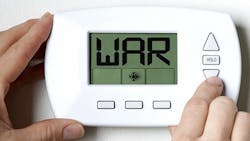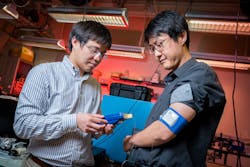Shortly after beginning Clark’s Remarks, I poked fun – good naturedly, of course – at my wife for always complaining about being cold in air conditioning buildings, a fact that she had gleefully shared with my bosses the week that I started a new job at an AC company.
At the time I wrote that – September 2013 – I was not aware of a report published the previous year in Indoor Air, in which various scientific studies on the effects of gender on indoor thermal comfort were examined. In more than half of those studies, women were more uncomfortable than men at the same temperature and relative humidity conditions. The women were also more sensitive to changes in indoor temperatures, especially when the temperature was reduced. It turned out that science had an explanation, based on differences in physiology between men and women. In May 1998, the British medical journal Lancet confirmed the old adage “cold hands, warm heart” when they reported that, in spite of women having slightly higher core temperatures than do men, their hands are measurably colder. So in February 2015, I fessed up to my wife and all of the other women who may have felt unfairly maligned.
Studies show indoor temperature affects cognitive performance differently for men and women.
Now, two researchers at USC’s Marshall School of Business and WZB Berlin Social Science Center, Tom Y. Chang and Agne KajackaiteI, have published “Battle for the Thermostat: Gender and the Effect of Temperature on Cognitive Performance”. Their research not only confirms that women usually want to be warmer when they are inside, but that the indoor temperature affects cognitive performance differently for men and women. Based on a laboratory experiment using 543 university students in Berlin as test subjects, they studied the participant’s ability to perform math, verbal and cognitive reflection tasks at different indoor temperatures, ranging from 60 deg. F. to 91 deg. F.
For the math task, the subjects had to add 50 sets of five two-digit numbers in five minutes, without using a calculator. The verbal task required that the study participants create as many German words as they could in five minutes, using only the letters ADEHINRSTU. And the cognitive reflection test (CRT) required the subjects to answer three original questions in five minutes. The questions were designed so that the intuitive answer was not the correct answer. (e.g., “A bat and a ball cost $1.10 total. The bat costs $1.00 more than the ball. How much does the ball cost?” In this example, the intuitive answer is that the ball costs 10 cents, but that is incorrect. For the correct answer, skip to the bottom of this page).
A simplified summary of the results indicates that there was no relationship between temperature and CRT scores. There was, however, a correlation between the indoor temperature and the subject’s performance on the math and verbal problems, with the men performing best at lower temperatures and the women performing best at the higher temperatures. So it seems that, once again, my wife is on to something.
UC San Diego is developing a wearable prototype cooling/heating system that can be adjusted for user comfort.
Perhaps some engineers at the University of California San Diego have now found a peaceful solution to the thermostat battles. According to a report published in last month’s Science Advances, they have developed a soft, stretchable patch that can be embedded in clothing, and that will warm or cool a person’s skin to maintain a temperature comfortable to the wearer even as the ambient temperature changes.
Hmm, could make for a good gift idea some day.
(Correct answer: The ball costs 5 cents. The bat costs $1.00 more than the ball, or $1.05, so the total is $1.10.)
A regular contributor to HPAC Engineering and a member of its editorial advisory board, the author is a principal at Sustainable Performance Solutions LLC, a south Florida-based engineering firm focusing on energy and sustainability.
About the Author
Larry Clark
A member of HPAC Engineering’s Editorial Advisory Board, Lawrence (Larry) Clark, QCxP, GGP, LEED AP+, is principal of Sustainable Performance Solutions LLC, a South Florida-based engineering firm focused on energy and sustainability consulting. He has more than two dozen published articles on HVAC- and energy-related topics to his credit and frequently lectures on green-building best practices, central-energy-plant optimization, and demand-controlled ventilation.

